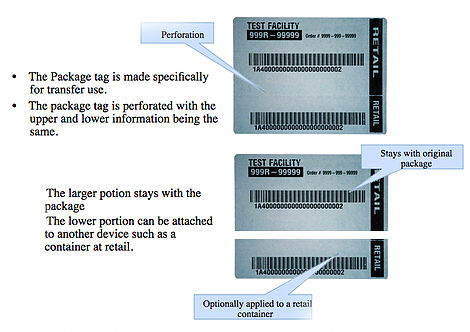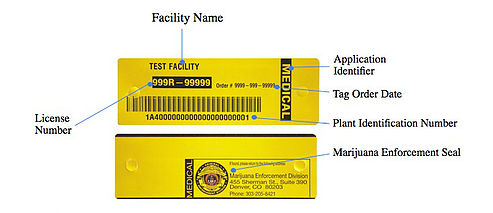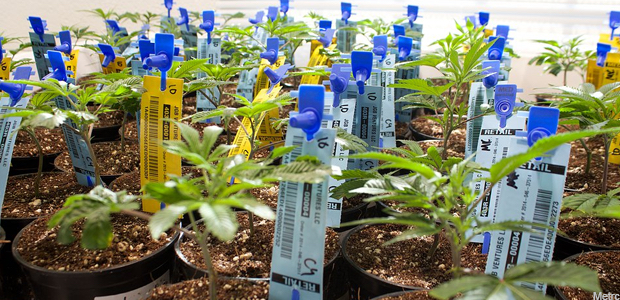What is METRC?
METRC is the reporting regulation system for California Cannabis Track-and-Trace (CCTT). Tracking products from seed-to-sale creates a lineage, or footprint, for each cannabis activity that a cannabis product experiences. What this means is that each plant is required to have its own unique identifier -or- barcode. It also means that products are able to be tracked from one end of the supply chain to the other (seed-to-sale). METRC is currently used in 11 states including the hemp farming that takes place in Colorado.
As a business owner in the state of California, you’ve recently undergone a significant amount of change. Let’s be honest here: adapting to change is not only difficult, but increases your overall operating costs.
This may seem like another roadblock that gets in the way of traditionally running an operation and conducting business like you “used to,” but there are lots of positives to the state-mandated use of METRC that will be seen as adjustments are made.
In an industry that has kept to the shadows for generations and is now reaching the mainstream media, a standardization process allows for legal licensees to separate themselves from an illicit and potentially dangerous underground market. The result is the elimination of the negative stigma that cannabis carries with it.
Related: A Definitive Guide to Compliance — California Cannabis Dispensaries
METRC as a Filing Cabinet
Think of METRC as the filing cabinet for cannabis products that you’ve never had. The products themselves are the actual files which need to be kept in order. This gives businesses statistics in real-time that can actually influence your financial projections and aid in the way in which you organize your business activities.
Traditionally, filing cabinets are used to organize your most important documents with the intention of being able to access data for the respective subject.
Each file needs a way of being organized so as to easily correlate with records and in-turn create a list of matching serial numbers for products.
This concept is carried over to the cannabis industry and provides a critically important way of legitimizing the industry’s inventory overall. More importantly, METRC can help you, as as business owner, stay compliant and increase organization which in-turn results in the ability to process more orders and avoid fines.
Seeds, clones, and flowering plants are tagged at the beginning of their life cycle. At the time of harvest, all waste and changes that the plants undergo is recorded. As plant material is then sent to manufacturers, each is scanned again to give real-time data on their current and previous locations. From manufacturers to distributors, cannabis goods are scanned and then again from distributors to the testing facilities before being returned for distribution to retail locations.
All testing results are uploaded to METRC, which then allows for the entire lifespan of the product to be traced as it is moved to or sold from a retail location to the end consumer.
Not only does METRC help in keeping licensed businesses honest, but it actively promotes the integrity of the industry as a whole by allowing employees access to any and all information on products you carry. This legitimizes the industry while taking into account the safety of consumers.
What tags are used with METRC?
You might be thinking about the way that METRC keeps track of each product in order to keep an accurate ledger across the state so let’s take a little bit of time to explain the way that this system keeps records:
Radio Frequency Identification (RFID): A barcode that holds numerical value and stores data for individual or batches of plants. Think of this as any barcode that you’ve seen on common items. This maintains the integrity of cultivation operations by keeping data that is immediately accessible on immature cannabis plants, teens, and mature plants that are flowering prior to harvest.
Unique Identifier (UID/UDID): This tag is put onto plants which are then organized by lots of up to 100 plants per lot. If there is a combination of cannabis goods, they each get combined and put into the same package which can then be traced throughout the entirety of the lifespan of that product.
Package Tag: Intended to be placed on each package that is carried en-route to and from locations. Examples of this might be batches of flower sent to a retailer to be sold or edibles which have been manufactured and are ready for testing, prior to distribution. The tags to be used when transporting plants or cannabis goods. This tag can be placed on containers for retail locations which are scanned at the time of sale, aiding in proper METRC technique.

METRC’s RFID Package Tag
Source: METRC
Plant Identification Numbers: Serial numbers used to keep a linear record of products. Having a serial number on each product allows for an accurate numerical record to be kept. This enables the track record of a product to be kept from start to finish. Guessing inventory quantity or using square footage to estimate the amount of canopy space is eliminated with a sequential manner of keeping records. All cannabis products fall under this linear organization. Lot tags state the facility name at the top with a license number directly beneath it. On the side of the tag is a categorization of either Adult-Use or Medical as well as the date that the tag was created. At the bottom, is a Plant ID number, or, serial number.

METRC’s Plant Tag
Source: METRC
METRC for Cultivators

Source: GCN
As a cultivator, the task of METRC-integration may seem extremely tedious, especially when considering the size that a canopy has the potential of growing to. Your concerns may be eased when being told that RFID scanning won’t disturb plants as they grow and can be scanned form upwards of 15 feet away. This means that in theory—seeds, clones, and mature plants won’t need to be disturbed for the sole reason of reporting to METRC.
From seed to clone & harvest to trimming, all information is now going to be kept. Inclusive of this is the transfer of plants from one location to the other, the amount of waste that a cultivator produces, the destruction of plants due to various reasons, and finally, testing results when the plant material is manufactured. Accountability is central with METRC and nothing illustrates this more than the ability to trace products all along the supply chain, back to the origin.
METRC for Retailers
As it stands, METRC integration is a looming part of this industry that truly requires a lot of attention for retail and delivery service owners. Temporary licensees do not need to integrate with METRC and instead, will wait until they receive a permanent license.
True integration begins when a permanent license is granted to any given dispensary or delivery service. From the time that you receive a permanent license, METRC training begins—and it’s no easy task.
METRC requires that all sales be reported at the end fo each day with an inventory reconciliation taking place once every 30 days. As previously explained, METRC tracks each and every product along the entirety of it’s lifespan in the supply chain. Retailers that fail to report to METRC are simply operating in a non-compliant manner.
It’s a race against the clock!
Requiring that METRC training is completed within 5 days of the issuance of a permanent license means that managerial staff and/or owners must complete the entirety of training sessions provided to them by the state.
5 days for completing the METRC certification may not seem like a lot of time to absorb information that is at the core of avoiding fines and keeping your license in good standing by being compliant; and it isn’t.
Considering that a 30-day window for full METRC integration of current inventory starts at the same time as the certifications for staff members, the race against the clock is on!
The 30-day framework mandates that all inventory be uploaded to METRC using the above UID numbers. More specifically, current inventory that is in progress of being uploaded to the database is accepted and anything outside of this, must have trace information from the time that it is a seed.
In short, you have 5 days to complete METRC certification and 30 days to upload all information of current inventory once you receive a permanent license. After those 30 days, all METRC-required information must start at the seed or clone stage of CCTT—meaning that your physical, POS, and CCTT information must match.
Each and every sale that is made is technically called a “change of custody,” requiring that a new report to the state’s system must be made. This includes purchases from distributors, records for certificates of analysis (COA), distributor license numbers, shipping manifests, and request receipts.
Hiring a compliance officer is the new standard.
Hiring an employee that solely focuses on METRC reporting and integration is an excellent way of being sure that you maintain a culture of compliance. This new door will not only allow individuals to enter the industry, but aid in maintaining the integrity of your business.
Uploading CSV files or manually importing data at the end of every day is not only time consuming, but provides a large margin for error.
Having an in-house compliance expert ensures that fines are avoided and that audits are maintained on a regular basis. The new standard of hiring a compliance expert goes deeper than that—it means that the entirety of your staff ought to be trained and understand the proper standard operating procedures (SOP) of your business. After all, you’re responsible for explaining mistakes made to the state should there be any discrepancy.
Related: Looking at Cannabis Compliance with Jordan Wellington from Simplifya
How does this benefit consumers?
Mindfulness of the available products is one aspect of METRC-integration that shines in a positive way. The ability to track the origins of plants and products overall helps legitimize the industry. The creation of a standard for the industry as a whole is vital to breaking barriers and giving individuals access to a substance that has tremendous benefits.
This standard also paves the way for ensuring that cannabis goods are safe to consume—something that we ought to take into consideration for all customers—new & experienced.
METRC is an adjustment for everyone in the California marketplace right now. Guessing the number of plants that you have as a cultivator is no longer acceptable and for retail owners, simply keeping a paper ledger for your business is outdated.
And although METRC integration may feel like an unnecessary way of keeping track of products, the positives far outweigh the negatives. Some of the positives include, but are not limited to: increased reliability and safety for consumers as the result of tracing products from seed-to-sale, the organization of sale ledgers as the result of an electronic database, and on-the-spot projections for products you sell to consumers. The latter allows for you to maximize profitability by offering what is in demand.
METRC changes the legitimacy of cannabis operations
Finally, for the first time in California’s history, cannabis has the ability to take the stage, front-and-center. With this in mind, lifestyle brands are emerging, education about the industry is booming, and the interest of first-time consumers is being attracted.